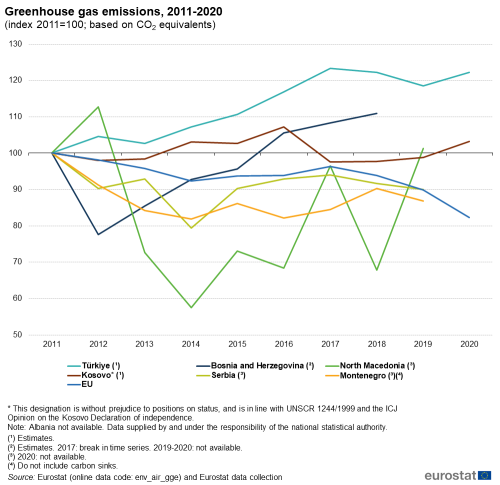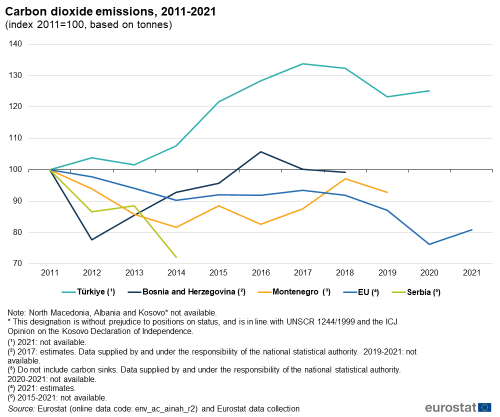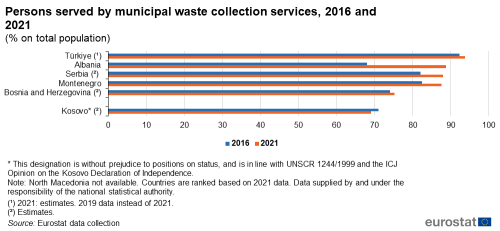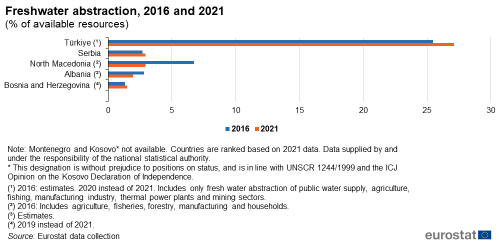Enlargement countries - environment statistics
Data extracted in May 2023.
Planned article update: May 2024.
Highlights
Among the candidate countries and potential candidates, Montenegro was the largest generator of municipal waste relative to population size in 2021, at 515 kg per inhabitant.
Over the period 2011-2020, greenhouse gas emissions were reduced in Montenegro (-13.1 %) and Serbia (-10.0 %).
Greenhouse gas emissions, 2011-2020 (index 2011=100; based on CO2 equivalents)
This article is part of an online publication and provides information on a range of environment statistics for the Western Balkans and Türkiye and compares this with the corresponding data for the European Union (EU). Within this region, Bosnia and Herzegovina, Montenegro, North Macedonia, Albania, Serbia and Türkiye are candidate countries, while Kosovo* has the status of potential candidate. Data for Georgia, Moldova and Ukraine, granted candidate status or European perspective by the European Council in June 2022, are not included in this article; Statistics Explained articles on the European Neighbourhood Policy-East countries are available here.
This article provides some information in relation to climate change, waste and water, presenting indicators such as the level of greenhouse gas emissions, municipal waste generated and waste treated, and water abstraction.
*This designation is without prejudice to positions on status, and is in line with UNSCR 1244/1999 and the ICJ Opinion on the Kosovo declaration of independence.
Full article
Greenhouse gas and carbon dioxide emissions
The gases considered in this article as greenhouse gases are carbon dioxide (CO2), nitrous oxide (N2O), methane (CH4), hydrofluorocarbons (HFCs), perfluorocarbons (PFCs) and sulphur hexafluoride (SF6). Figure 1 shows development in the combined emissions of these gases, measured in carbon dioxide equivalents. The basic data are annual emissions estimated and reported according to the Intergovernmental Panel on Climate Change (IPCC) guidelines.
A rapid increase in greenhouse gas emissions was reported for North Macedonia between 2011 and 2012, followed by a sharp fall in 2013-2014 and then further increases in 2015 to fall again in 2016, grow back in 2017 and decrease again in 2018 to finally rise in 2019, such that between 2011 and 2019 (the most recent data available) the overall increase was 1.3 %. The time series for Türkiye reflects an almost unbroken series of annual increases in greenhouse gas emissions during the period shown with the only falls recorded in 2013, 2018 and 2019; the overall increase in emissions in Türkiye between 2011 and 2020 was 22.3 %. After decreases between 2011 and 2012, the time series for Kosovo shows a series of increases in 2013, 2014 and 2016, which was followed by a fall in emissions in 2017, stability in 2018 and a slight increase in 2019 and 2020, such that the level of emissions in 2020 was 1.3 % above the level in 2011. Serbia has recorded an overall decline of 10.0 % in greenhouse gas emissions from 2011 to 2019, with a low point in 2014 (-20.6 % compared with 2011). In Bosnia and Herzegovina, there was a significant decrease in emissions between 2011-2012, followed by a substantial increase between 2013 and 2018, reaching the highest point (+33.3 % compared with 2012); leading to an overall increase of emissions of 10.9 % between 2011 and 2018 (more recent data not available). The time series for Montenegro saw an overall decrease over the period excepted small increases in 2015, 2017, and 2018, reaching a level of emissions in 2020, 13.1 % lower than in 2011.
The index for total greenhouse gas emissions in the EU reflects an overall fall of 17.7 % in these emissions between 2011 and 2020. Emissions in the EU fell steadily between 2011 and 2014. Between 2015 and 2017, the level of emissions increased, followed by declines in 2018 and 2019, and then increased again in 2020.

(2011 = 100; based on CO2 equivalents)
Source: Eurostat (env_air_gge) and Eurostat data collection
Carbon dioxide is one of the greenhouse gases: while it has the lowest global warming potential of the six greenhouse gases, emissions of this gas in the EU are much higher than any of the other greenhouse gases. Even when adjusted for global warming potential, the impact of carbon dioxide emissions is far greater than the other greenhouse gases. In consequence, the developments shown in Figure 2 reflect those seen in Figure 1, for the countries where data is available. Türkiye (data to 2020) reported an increase of its emissions from 2011 to the latest available year (+25.2 % from 2011 to 2020), while Bosnia and Herzegovina (data to 2018), Montenegro (data to 2019) and Serbia (data to 2014) reported a decline. The CO2 emissions of the EU in 2021 were 19.1 % below the figure ten years earlier.

(index 2011 = 100, based on tonnes)
Source: Eurostat (env_ac_ainah_r2) and Eurostat data collection
Municipal waste
Municipal waste is mainly produced by households, though similar wastes from sources such as distributive trades, offices and public institutions are included in the data presented. Waste from agriculture and from industry is excluded from this indicator. Municipal waste consists of waste collected by or on behalf of municipal authorities and disposed of through the waste management system. For areas not covered by a municipal waste collection scheme, the reporting countries estimate the amount of waste generated.
Among the candidate countries and potential candidates, the quantity of municipal waste generated ranged in 2021 from 270 kilograms (kg) per inhabitant in Kosovo to 515 kg in Montenegro. The quantity of municipal waste generated per inhabitant increased from 2011 to 2021 in North Macedonia (+28.6 %) and Albania (+13.9 %, between 2013 - oldest data available - and 2021), and in Bosnia and Herzegovina (+3.5 %, between 2011 and 2019 – most recent data available) while it fell in Türkiye (between 2011 and 2020 – most recent data available) and Montenegro by 4.3 % and 1.9 %, respectively. Serbia remained stable between 2011 and 2020 (most recent data available; -0.2 %). There is no 2011 data available for Kosovo. In 2021, the amount of municipal waste generated per inhabitant in the EU was 530 kg. This was more than the amount generated per person in 2011, at 499 kg per inhabitant (+6.2 %).
Waste can be treated in a number of ways, with waste treatment processes categorised either as disposal, including landfill and incineration without energy recovery or as recovery. This includes, for example, material recycling, composting and incineration with energy recovery. The data are shown in Table 1. Data is collected every two years.
In Türkiye treated waste in 2020 had more than doubled from 2010 (+177.5 %) to reach 153.3 million tonnes. Over the same period, treated waste in Serbia increased by 75.5 % (58.2 million tonnes in 2020) while it declined in North Macedonia by 30.8 % (1.5 million tonnes in 2020). From 2012 (no 2010 data available) to 2020, treated waste increased by 5.2 % in Montenegro (1.1 million tonnes in 2020). In Kosovo, treated waste rose by 556.0 % from 2016 (oldest data available) to 2020 (2.6 million tonnes in 2020). There is data only for 2014 in Albania (1.2 million tonnes of waste treated). There is no data available for Bosnia and Herzegovina. In the EU, there was a decrease in waste treated by 2.9 % between 2010 and 2020, to 2.0 billion tonnes.

(thousand tonnes)
Source: Eurostat (env_wastrt)
In 2021, the proportion of persons served regularly by municipal waste collection services ranged from 69 % in Kosovo to 94 % in Türkiye (2019 data – more recent data not available), as shown in Figure 4. In all the countries for which data are available, the proportion of persons from whom waste was regularly collected increased from 2016, except in Kosovo, where it declined from 71 % in 2016 to 69 % in 2021. Albania recorded the highest increase, from 68 % in 2016 to 89 % in 2021, while Bosnia and Herzegovina recorded the smallest increase: from 74 % in 2016 to 75 % in 2020 (no 2021 data available). Türkiye had a close but bigger increase between 2016 and 2021 from 92 % to 94 %. Serbia and Montenegro both recorded a mild increase during this period: Serbia up by 6 percentage points (pp) to 88 %; and Montenegro up by 5 pp to 88 %.
Water and wastewater
Freshwater abstraction as a percentage of available resources, as shown in Figure 5, is based on the resources available over the long term, a minimum of 20 years. For the five candidate countries and potential candidates for which data are available, this ratio ranged from just 1.5 % in Bosnia and Herzegovina in 2019 (most recent data available) to 27.1 % in Türkiye in 2020 (no 2021 data available). From 2016 to 2021, increases in this ratio were recorded in Türkiye (+1.7 pp, over 2016-2020), Serbia (+0.3 pp) and Bosnia and Herzegovina (+0.2&pp, over 2016-2019), whereas decreases were recorded in North Macedonia (-0.1 pp) and Albania (-0.8 pp, over 2016-2019 – most recent data available).
Source data for tables and graphs
Data sources
Data for the candidate countries and potential candidates are collected for a wide range of indicators each year through a questionnaire that is sent by Eurostat to candidate countries or potential candidates. A network of contacts has been established for updating these questionnaires, generally within the national statistical offices, but potentially including representatives of other data-producing organisations, for example, central banks or government ministries.
Eurostat, in close partnership with the European Environment Agency (EEA), provides environmental statistics, accounts and indicators supporting the development, implementation, monitoring and evaluation of the EU’s environmental policies, strategies and initiatives. Data on greenhouse gas emissions as reported under the United Nations framework convention on climate change (UNFCCC) are collected by the EEA. Eurostat collects official statistics in relation to a broad selection of subject areas, for example, waste, water, material flows and environmental protection expenditure.
The Kyoto Protocol, an environmental agreement adopted by many of the parties to the UNFCCC in 1997 to curb global warming, covers six greenhouse gases: carbon dioxide (CO2), methane (CH4) and nitrous oxide (N2O), which are non-fluorinated gases, and hydrofluorocarbons (HFCs), perfluorocarbons (PFCs) and sulphur hexafluoride (SF6), which are fluorinated gases. Converting them to carbon dioxide equivalents makes it possible to compare them and to determine their individual and total contributions to global warming. A new agreement on greenhouse gas emissions was reached in Paris in late 2015; this provides the basis for emissions mitigation and adaptation from 2020 onwards.
Eurostat’s data on waste is collected from EU Member States on the basis of a Regulation on waste statistics (2150/2002/EC) and is published every two years in line with common methodological recommendations. Landfill is the deposit of waste into or onto land; it includes specially engineered landfill sites and temporary storage of over one year on permanent sites. The definition covers both landfill in internal sites, in other words, where a generator of waste is carrying out its own waste disposal at the place of generation, and in external sites.
Tables in this article use the following notation:
| Value in italics | data value is forecasted, provisional or estimated and is therefore likely to change; |
| : | not available. |
Context
In January 2014, the European Commission put forward a 2030 climate and energy framework with the aim of encouraging private investment in infrastructure and low-carbon technologies. The key targets proposed were to have 40 % less greenhouse gases in 2030 than in 1990 and for the share of renewable energy in consumption to reach at least 27 % by 2030. Alongside the proposed targets were plans to reform the emissions trading system and to consider further amendments to the energy efficiency directive. The EU’s 2050 long-term strategy for reducing greenhouse gas emissions was laid out in November 2018, with the aim of making Europe the world’s first climate-neutral continent by 2050 in response to the climate and environmental emergency. In consequence, the European Commission announced the European Green Deal in December 2019. This is an action plan in support of the 2050 long-term strategy which with a further reduction in 2030 greenhouse gas emissions compared with 1990 levels; invest in research and innovation; and preserve Europe’s natural environment. The European Climate Law, which entered into force in 2021, considers the actions required across all sectors, including a reduction of 2030 greenhouse gas emissions compared with 1990 levels of at least 55 %, to be implemented through support for increased energy efficiency and renewable energy. This will enable the EU to move towards a climate-neutral economy and implement its commitments under the Paris Agreement. This process has resulted in a proposal before the European Parliament for a European Strategy for Energy System Integration. In December 2015, a global agreement was reached at the 2015 United Nations’ climate change conference in Paris; this was signed by 174 parties in New York in April 2016 and opened for ratification. The agreement sets out an action plan to avoid dangerous climate change by limiting global warming to well below 2°C.
Information concerning the current statistical legislation on environment statistics can be found here.
While basic principles and institutional frameworks for producing statistics are already in place, the candidate countries and potential candidates are expected to increase progressively the volume and quality of their data and to transmit these data to Eurostat in the context of the EU enlargement process. EU standards in the field of statistics require the existence of a statistical infrastructure based on principles such as professional independence, impartiality, relevance, confidentiality of individual data and easy access to official statistics; they cover methodology, classifications and standards for production.
Eurostat has the responsibility to ensure that statistical production of the candidate countries and potential candidates complies with the EU acquis in the field of statistics. To do so, Eurostat supports the national statistical offices and other producers of official statistics through a range of initiatives, such as pilot surveys, training courses, traineeships, study visits, workshops and seminars, and participation in meetings within the European Statistical System (ESS). The ultimate goal is the provision of harmonised, high-quality data that conforms to European and international standards.
Additional information on statistical cooperation with the candidate countries and potential candidates is provided here.
Direct access to
- Enlargement countries — statistical overview — online publication
- Statistical cooperation — online publication
- All articles on environment
- Greenhouse gas emission statistics
- Municipal waste statistics
- Environment statistics introduced
- Statistical books/pocketbooks
- Key figures on enlargement countries — 2019 edition
- Key figures on enlargement countries — 2017 edition
- Key figures on the enlargement countries — 2014 edition
- Energy, transport and environment indicators — 2019 edition
- Factsheets
- Basic figures on the candidate countries and potential candidates — Factsheets — 2023 edition
- Basic figures on Western Balkans and Türkiye — Factsheets — 2022 edition
- Statistics for a green future — Western Balkans and Türkiye — Factsheets — 2022 edition
- Basic figures on enlargement countries — Factsheets — 2021 edition
- Leaflets
- Basic figures on enlargement countries — 2020 edition
- Basic figures on enlargement countries — 2019 edition
- Basic figures on enlargement countries — 2018 edition
- Energy and transport statistics for the enlargement countries — 2018 edition
- Basic figures on enlargement countries — 2016 edition
- Greenhouse gas emissions by source sector (source: EEA) (env_air_gge)
- Air emissions accounts by NACE Rev. 2 activity (env_ac_ainah_r2)
- Candidate countries and potential candidates (cpc) (ESMS metadata file — cpc_esms)
- Greenhouse gas emissions by source sector (source: EEA) (ESMS metadata file — env_air_gge)
- Air emissions accounts and intensities (ESMS metadata file — env_ac_ainah_r2)
- Communication COM/2011/0021 final A resource-efficient Europe – Flagship initiative under the Europe 2020 Strategy
- Decision No 1386/2013/EU of 20 November 2013 on a General Union Environment Action Programme to 2020 ‘Living well, within the limits of our planet'


